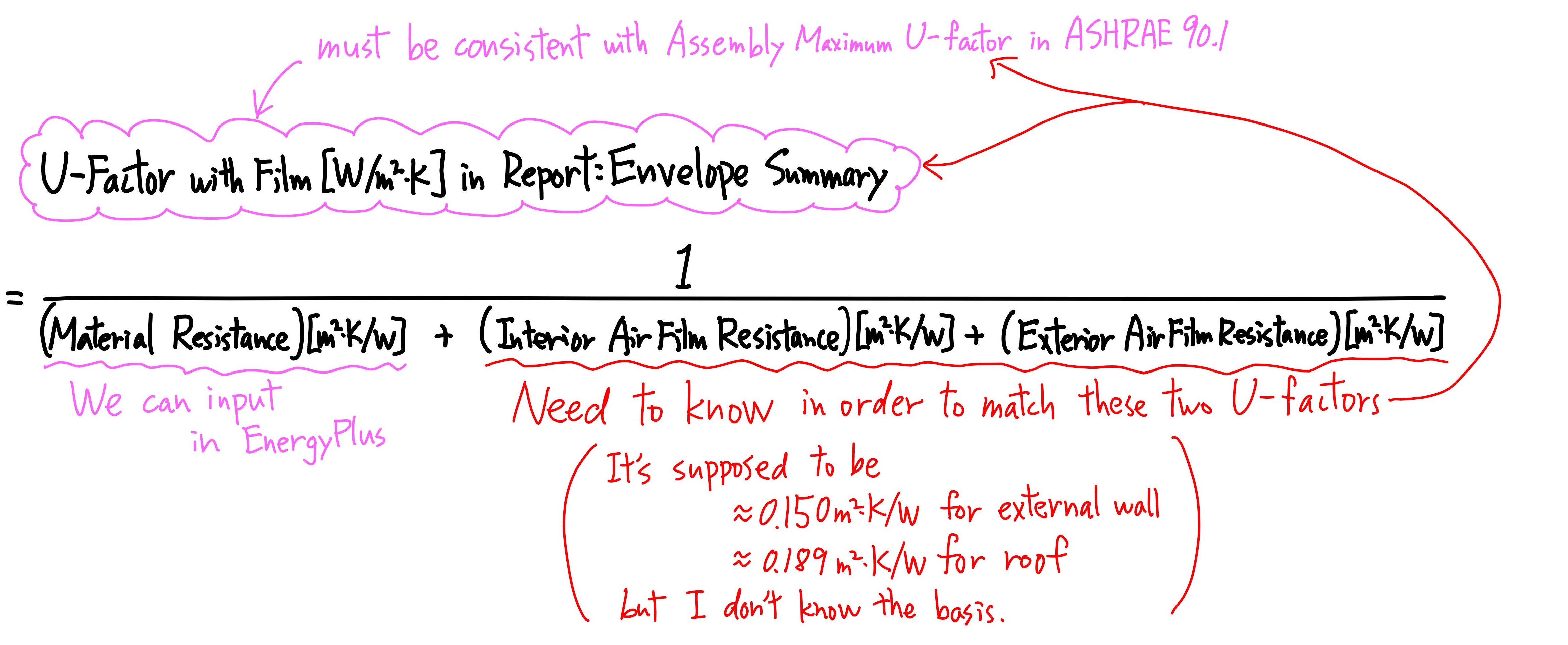What is the basis for Air Film Resistances used to calculate U-Factor with Film?
ASHRAE 90.1 prescribes assembly maximum U-factors for walls and roofs, and the U-factors need to be used for baseline case.
From the definition of U-factor in ASHRAE 90.1, it includes resistances of interior air film and exterior air film.

U-Factor with Film [W/m2·K] can be found in Report: Envelope Summary. I think we must match U-Factor with Film with the assembly maximum U-factor prescribed in ASHRAE 90.1 for baseline case.
However, Thermal Resistance [m2·K/W] in Material:NoMass does Not include Interior/Exterior Air Film Resistances. The input Thermal Resistance is equal to the reciprocal of U-Factor no Film.
Therefore, in order to match U-Factor with Film with the assembly maximum U-factor prescribed in ASHRAE 90.1, we need to know the Interior Air Film Resistance and Exterior Air Film Resistance that are used to calculate U-Factor with Film. Please refer to my sketch below.

I know that air film resistance is calculated for each time step based on weather data during energy simulation. But for this U-Factor with Film, I did some case studies with different Thermal Resistance and different weather data, calculated (Interior Air Film Resistance) + (Exterior Air Film Resistance) from the above equation, and found that (Interior Air Film Resistance) + (Exterior Air Film Resistance) was always about 0.150[m2·K/W] for external wall and about 0.189[m2·K/W] for roof. They had nothing to do with weather data. But I don't know what is the basis for these Air Film Resistances? Does anyone know how they are calculated?
I may have overlooked it, but I couldn't find the basis in EngineeringReference and I/O Reference. If possible, I want to know each value of Air Film Resistance: Interior Air Film Resistance and Exterior Air Film Resistance.
P.S.
I noticed my mistake, so please let me correct it.
(Interior Air Film Resistance) + (Exterior Air Film Resistance) for roof is not about 0.189[m2·K/W] but about 0.1373[m2·K/W]. Interior Air Film Resistance for roof is 0.1074271[m2K/W], and Exterior Air Film Resistance for roof is 0.0299387[m2K/W].
In my case study, I mistakenly selected Surface as Outside Boundary Condition of the roof in BuildingSurface:Detailed. Therefore, the roof was recognised as "semi-exterior" surface and 0.0810106[m2·K/W] was used, which resulted in 0.1074271+0.0810106≈0.189[m2·K/W]. After changing Outside Boundary Condition of the roof from Surface to Outdoor, 0.0299387[m2K/W] was used for Exterior Air Film Resistance, and (Interior Air Film Resistance) + (Exterior Air Film Resistance) = 0.1074271+0.0299387 ≈ 0.1373[m2K/W].
For the best answer, please refer to the link that @JasonGlazer attached in his comment. The basis for R-values (Air Film Resistances used to calculate U-Factor with Film) is ASHRAE Standard 90.1 (I-P Edition) Section A9.4.1. Then, the unit is converted from [h·ft2·°F/Btu] to [m2·K/W ...






Thanks for letting us know the basis of the calculation for the air film resistance. I just wanted to know as you mentioned " air film resistance is calculated for each time step" is that true or the value of the air film resistance remains constant?
@sachin_arq, air film resistance for exterior surfaces is calculated for each time step because the outdoor wind speed in weather files changes. In any algorithm, the surface exterior convective heat transfer coefficient is a function of wind speed. The air film resistance for the interior surfaces may be constant. Anyway, the air film resistance I talked about in this question is at the rated condition.